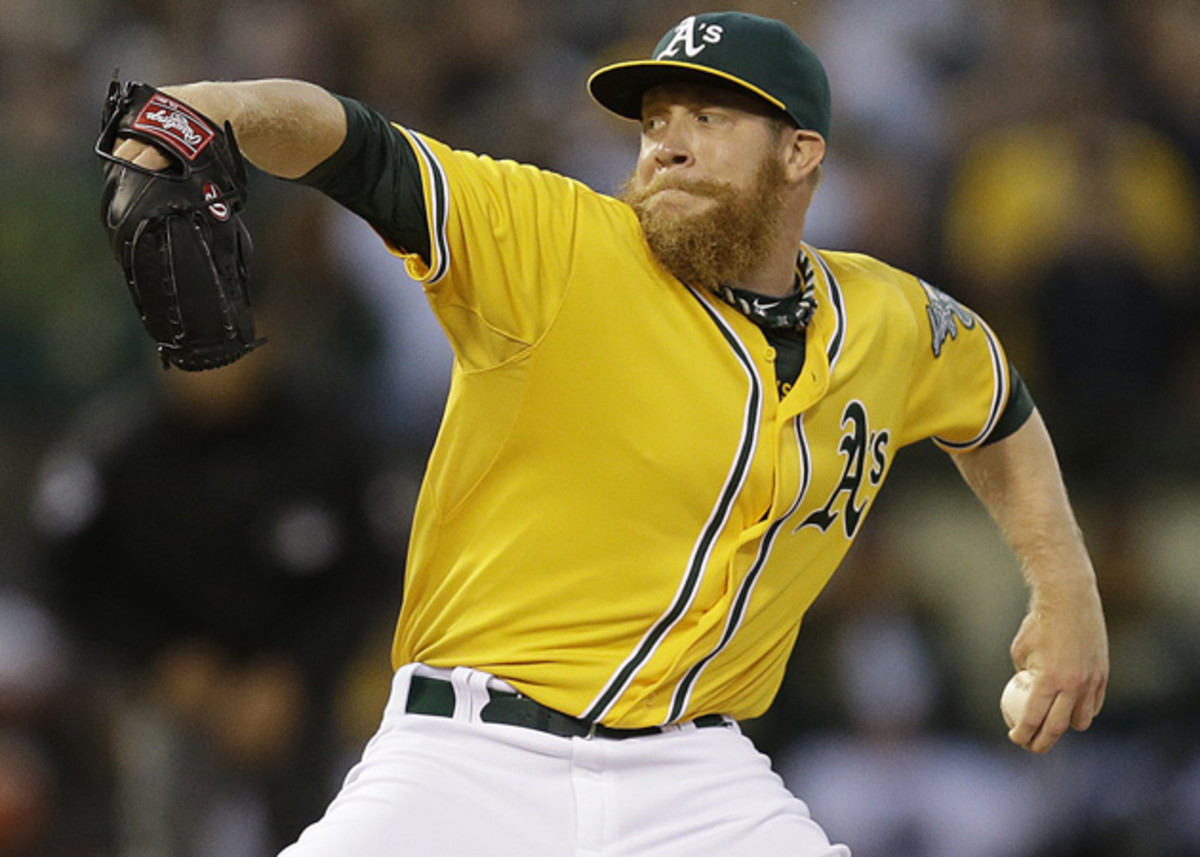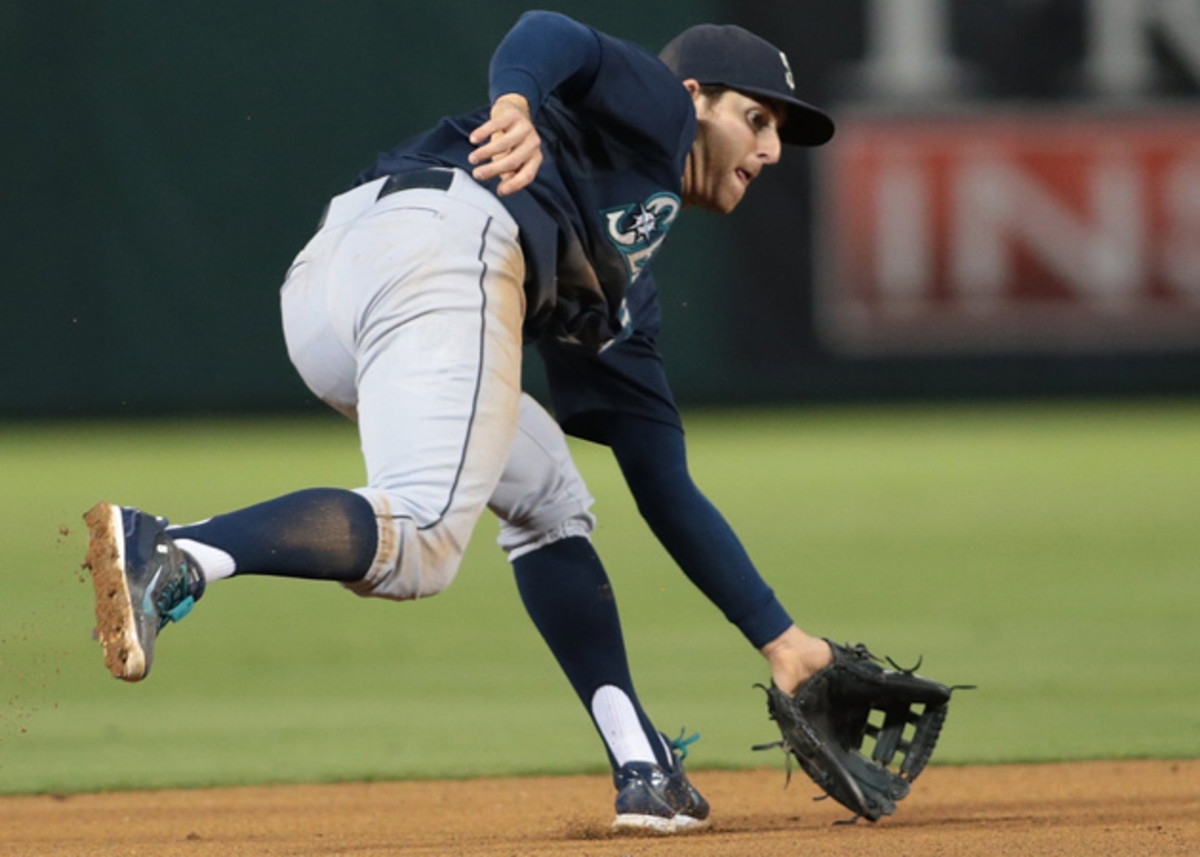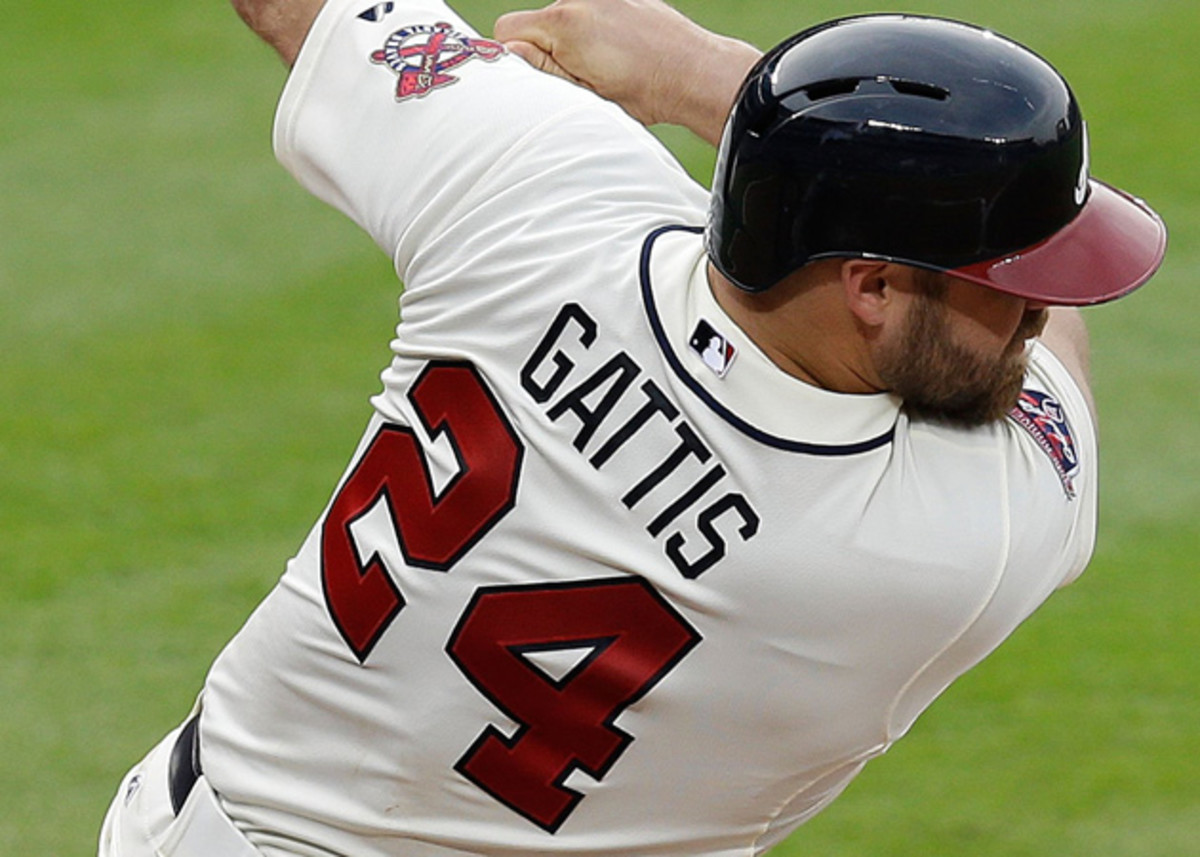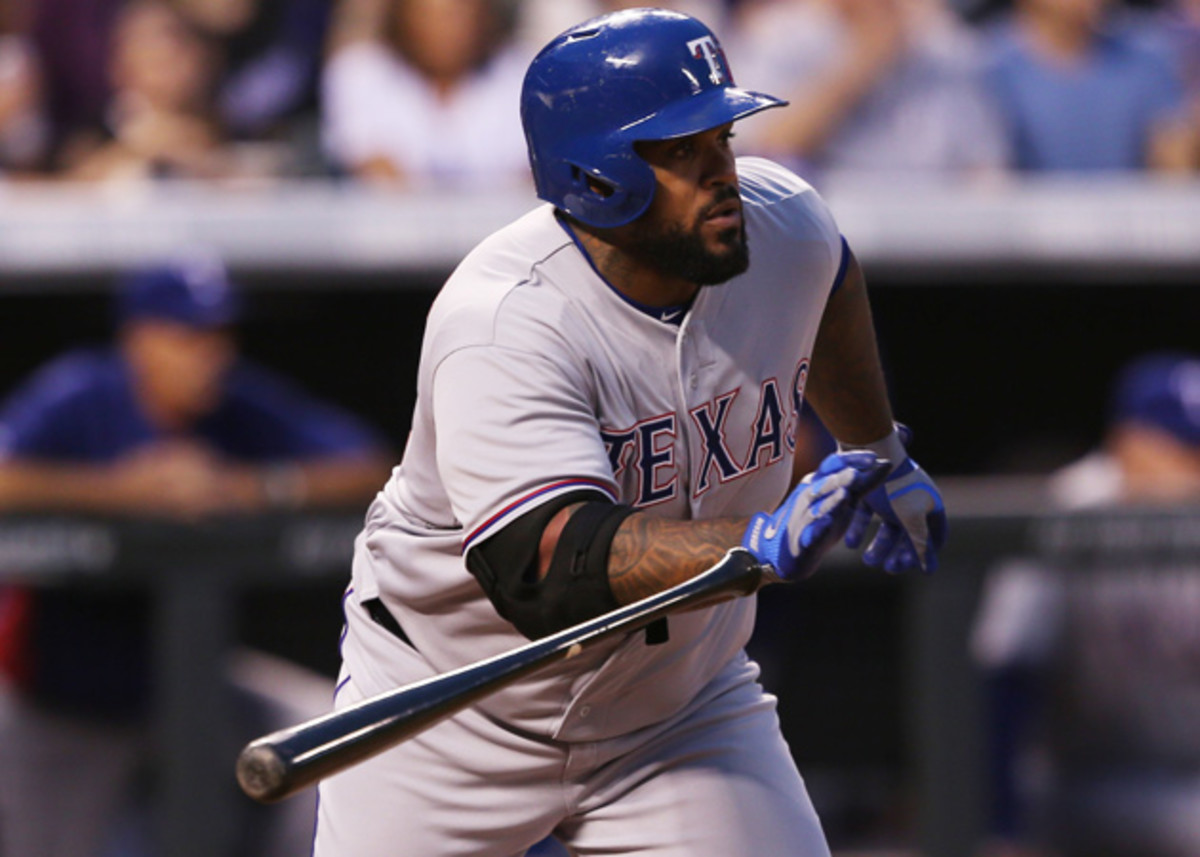Spring training preview: American League West

Over the next few days, SI.com will break down what to watch for in each team's camp as part of our spring training preview by looking at the Big Question, Big Position Battle and Big Prospect for all 30 clubs. Teams are listed by their order of finish from 2014. Note: The Big Prospect is a player who will be in major league camp but has not yet debuted in the major leagues.
• PREVIEWS:AL East | NL East | AL Central | NL Central
Angels | Athletics | Mariners | Astros | Rangers
Los Angeles Angels of Anaheim
The Big Question: How soon will Garrett Richards be ready and will his knee injury cause any other issues?
Richards was the third-most-valuable Angel in 2014 by Baseball-Reference.com's Wins Above Replacement, trailing only outfielder Mike Trout (of course) and since-traded second baseman Howie Kendrick. At 26, Richards emerged as the staff ace last year, but his breakout season came to an early and ugly end when he tore the patellar tendon in his left knee covering first base at Fenway Park on Aug. 20. Richards had surgery to repair the knee just two days later, reported to camp early, and threw his first bullpen since the surgery on Monday with good results. Still, the Angels don't expect Richards to be ready until later in April.
It's certainly a positive that the injury he's attempting to come back from was not to his arm, but it's not uncommon for pitchers to alter their mechanics due to a lower body injury, which can reduce their effectiveness at best and result in an arm injury at worst. Richards has to overcome whatever mental and physical hurdles might prompt him to make such a subtle change and will then be expected to return to his 2014 form, which was partially the result of an up-tick in velocity and good luck on balls in play (.264 BABIP). He has the next two months to try to rise to that challenge.
• POWER RANKINGS: How do teams stand heading into spring training?
The Big Battle: Second base
The biggest move Los Angees made this offseason was sending Kendrick, who is entering his walk year, to the Dodgers for former Marlins prospect Andrew Heaney. Heaney is a significant addition to the organization as a potential front-of-the-rotation starter who should be among the Halos' starting five this year. However, the team did not adequately replace Kendrick, resulting in a wide-open competition at second base.
Winter Report Card: Los Angeles Angels
Among the combatants: Josh Rutledge, who will turn 26 in April and is a .259/.308/.403 hitter in 947 career plate appearances despite spending his career with the Rockies (Rutledge has hit .230/.274/.354 on the road in the majors); Grant Green, 27 and a career .259/.293/.347 hitter in 256 major league PA; ex-Royal Johnny Giavotella, 27 and a career .238/.277/.334 hitter in 465 major league PA; and Rule 5 pick Taylor Featherston, who is 25 and has never played above Double A. All four of those players are righthanded, so there is no platoon option unless the Angels want to give the bulk of the starts to 23-year-old non-roster lefty Alex Yarbrough, who has also not played above Double A. Rutledge is the favorite, but it seems likely that the man who will play second base for the Angels down the stretch this season isn't yet in the organization.
The Big Prospect: Sean Newcomb, LHP
The 15th pick in last June's draft, Newcomb is a sturdy 6'5" lefty out of the University of Hartford who will turn 22 in June and arrived in the pros last year with a four-pitch arsenal (mid-90s fastball, slider, curve, change). Projected as more of mid-rotation innings eater, Newcomb seems to be on the fast track to the majors given that he's already been invited to major league camp and should start his first full professional season in High A. With Jered Weaver and C.J. Wilson due to become free agents after the 2016 season, Newcomb should arrive right on time.

Oakland Athletics
The Big Question: Will Sean Doolittle get into any exhibition games?
The A's announced in late January that Doolittle, the team's All-Star closer, had a slight tear in the rotator cuff in his pitching shoulder and might open the season on the disabled list. Doolittle did not have surgery, though, instead opting for platelet-rich plasma injections, and he is attempting to allow the injury to heal on its own with rest and rehabilitation.
Winter Report Card: Oakland Athletics
Doolittle passed along an encouraging update last week, and the team remains hopeful that he won't miss much of the regular season. Still, these rehab time frames have a habit of stretching out, and it's curious that news of Doolittle's injury came out just days after Oakland made a mid-January trade to get Tyler Clippard from the Nationals. Exactly how much Doolittle does in camp could tell us a lot about how quickly he will return. The best sign would be his appearance in a couple of late-March exhibition games, which could set him up for a possible rehab stint and an early-to-mid April return.
As for the A's other significant pitching injuries, they don't expect Tommy John recipients Jarrod Parker or A.J. Griffin back until mid-season and will be especially careful with Parker, who is coming off the second TJ surgery of his career.
The Big Battle: Leftfield
The default setting here is a platoon of lefty Sam Fuld and righty Craig Gentry. Still, for all of his speed on the bases and in the field, Fuld — a 33-year-old who is a career .230/.312/.329 hitter against righties — is a troubling choice for the bulk of the at-bats at what is typically an offense-first position. Gentry's career .264/.327/.317 line against righties isn't inspiring, either, but it's close enough to Fuld's split that there's a real opportunity here for Gentry to claim the job on an everyday basis. After all, he's younger (31), faster and a better fielder than Fuld. The question is how well Gentry has recovered from the early-September concussion that brought an end to his 2014 season. Also in the mix are 25-year-old switch-hitting speedster Billy Burns, 26-year-old minor league slugger Mark Canha (a first baseman by trade) and non-roster invitee Jason Pridie.
• JAFFE: PED scandals couldn't sink career of retiring Giambi
The Big Prospect: Matt Olson, 1B
Drafted out of a Georgia high school in 2012 with the compensation pick received when David DeJesus signed with the Cubs, the 6'4" Olson turned 20 last year, then lit up the California League to the tune of a .262/.404/.543 line with 37 home runs and 117 walks. That's an admittedly offense-heavy league, but Olson still led it in home runs and walks. In fact, he led the entire minor leagues in walks and trailed only über-sluggers Kris Bryant and Joey Gallo in minor league home runs in 2014. Meanwhile, the only players twenty years old or younger to post a higher OPS than Olson in the Cal League last year were fellow top prospects Corey Seager of the Dodgers and Jesse Winker of the Reds, both of whom did so in far fewer plate appearances. With a strong '15 campaign, Olson could be in the mix for Oakland's first base job a year from now in what would be his age-22 season.

Seattle Mariners
The Big Question: Is Jesus Montero ready to be a major league contributor?
When last we saw Montero — former top-10 prospect, former catcher and former regular in the Mariners' lineup — it was late August. Montero, working his way back from an oblique strain, was on a rehab assignment with Seattle's short-season Northwest League team in Everett, Wash., and coaching first base, when Mariners scout Butch Baccala began taunting him about his weight and ordered an ice cream sandwich to be sent to Montero in the dugout. Incensed, Montero confronted Baccala with the ice cream and a bat, an incident that stopped short of actual violence but resulted in Baccala being fired and Montero being suspended for the rest of the season.
Acquired in January 2012 in what at the time seemed like a blockbuster four-player trade that sent pitcher Michael Pineda to the Yankees, Montero hit a disappointing .260/.298/.386 and split his time between catcher and designated hitter in '12, then saw his '13 season ended early by a 50-game suspension for his involvement with Biogenesis. Last spring, Montero reported to camp at a horribly out-of-shape 275 pounds, prompting general manager Jack Zduriencik to state that any expectations he had for Montero were gone. He appeared in just six major league games last year and has played in just 35 over the last two years combined.
Winter Report Card: Seattle Mariners
But despite all that, the 6'3" Montero managed to hit .286/.350/.489 in 409 plate appearances in Triple A, his best full-season performance since 2011, and was reportedly back to his target weight of 235 last month. "Best shape of his life" reports are admittedly a dime a dozen during spring training, but few of them concern a former elite hitting prospect who has shed 40 pounds. If the way the last two seasons ended served as a wake-up call to Montero, he may yet salvage his career. He's still just 25 and could get at-bats as a platoon partner for Logan Morrison at first base or at designated hitter, pushing Nelson Cruz into the outfield with increasing frequency. With five more years of team control over Montero, Seattle has good reason to give him another chance.
The Big Battle: Shortstop
The Mariners are going to make Taijuan Walker battle for a spot in their rotation, but there's little doubt that he'll eventually claim one, even if it's not in April (and if not, that might have as much to do as potential innings limits as with his spring training performances). More compelling will be the mano-a-mano battle between Chris Taylor and Brad Miller for the shortstop job. Miller, a former second-round pick who hit .334/.409/.516 in 219 minor league games, claimed the starting spot in mid-2013, but lost it to Taylor — a former fifth-round pick and career .318/.404/.461 hitter in 276 minor league games — in late July of last year amid a dismal showing at the plate. Seattle isn't willing to write off the 25-year-old Miller based on one lost season, however, and will force the 24-year-old Taylor to fight to keep the starting job.
Miller, a lefthanded hitter, has more power (18 home runs in 746 major league PA), but Taylor, a righthanded hitter, is the better fielder. Don't expect a platoon as a compromise: The Mariners are looking for one of these players to stake his claim as the team's shortstop through the end of the decade. One thing to pay particular attention to is Miller's strikeout rate, which jumped from 15.5 percent in 2013 to 23.1 percent last year. Whatever success or lack thereof he might have this spring in terms of results, his contact rate may be the most informative.
• VERDUCCI: The top 10 spring training storylines to watch
The Big Prospect: D.J. Peterson, 3B
The 12th pick in the 2013 draft out of the University of New Mexico, Peterson successfully made the leap to Double A last June and is rapidly coming up on Montero's heels as the potential first baseman of the future in Seattle now that Kyle Seager is locked in at third base through 2021. The inevitable position switch is just as well, as Peterson's play at the hot corner was questionable to begin with, but his bat is the real deal. Last year in his first full professional season, he hit .297/.360/.552 with 31 homers and 111 RBIs in a season split evenly between High A and Double A. The bulk of that production came for High Desert in the hitter-friendly California League, but his successful move to Double A at the age of 22 bodes well for his continued advancement. If Montero disappoints yet again, Peterson could pass him on the organizational depth chart by the end of the year.

Houston Astros
The Big Question: Where will Evan Gattis play?
The Astros' acquisition of Gattis from the Braves in January made a certain amount of sense until the team announced that catcher would not be his primary position in Houston. Gattis is indeed a below-average backstop, particularly when it comes to blocking pitches and throwing out runners (he's fairly average when it comes to pitch-framing), but despite his considerable power, he doesn't hit for enough average or draw enough walks for his bat to be a sure thing at the other side of the defensive spectrum. Early speculation suggested Gattis would get the bulk of his playing time in leftfield, which was actually the position he played most often with the Atlanta in 2013. However, general manager Jeff Luhnow admitted to being skeptical about Gattis' viability at the position last month, expressing a desire to see slick-fielding Jake Marisnick win that job despite the soon-to-be-24-year-old's struggles at the plate through his first 355 major league at-bats.
Winter Report Card: Houston Astros
That leaves designated hitter and first base, one of which will be occupied by Chris Carter, whose 37 home runs last year tied him with Giancarlo Stanton for the second most in the majors. That puts increased pressure on Jon Singleton to try to retain the first base job, though Carter and Gattis combined to play just 18 games at first base last year. Ultimately, Gattis could prove to be the Opening Day starter at any of those three positions, but that will depend as much on what the other players mentioned above do this spring as on how Gattis looks in leftfield and at first base in his opportunities there in exhibition play. His getting regular playing time at catcher isn't completely out of the question, either, particularly if Jason Castro gets hurt or continues his 2014 struggles.
The Big Battle: Closer
The incumbent is 36-year-old Chad Qualls, who converted 18 of 23 chances from mid-May through the end of last season, a poor 78-percent conversion rate. The challengers are veteran free-agent additions Luke Gregerson and Pat Neshek and 29-year-old Josh Fields. Neshek, 34, was a dominating All-Star setup man for the Cardinals last year, picking up his first six career saves in the process, but he has had an erratic career and would be an unconventional choice given his sidearm delivery. Gregerson, who will be 31 in May, has been one of the most consistent setup men in baseball over the last six seasons with the Padres and A's. But he has never compiled more than nine saves in a season (he has 19 in his career), has spent his career in extreme pitchers' parks and has seen his strikeout rate drop in each of the last two years.
Gregerson will likely be given first crack at the job — he has games-finished bonuses built into his three-year, $18.5 million contract — but Fields, who held the job in September 2013 and April '14, could steal it back. As a sophomore last year, Fields, who leans heavily on a mid-90s cutter, struck out 11.5 men per nine innings and posted a 2.09 fielding independent pitching mark. The big thing to watch with Fields this spring is his home-run rate. An extreme fly ball pitcher, he allowed just two home runs in 54 2/3 innings last year. Correction there could undermine his otherwise excellent peripherals.
• WATCH: Picking the biggest winners, losers from free agency
The Big Prospect: Carlos Correa, SS
Arguably the second-best prospect in all of baseball after Twins centerfielder Byron Buxton, Correa was the top pick in the 2012 draft and hit .325/.416/.510 as a 19-year-old in High A last year before a broken ankle ended his season in late June. That injury only heightens the interest in what will be Correa's first appearance in major league camp. As a shortstop who could be a middle-of-the-order hitter upon maturation, he is a potential franchise player, but he hasn't seen game action since breaking his fibula, an injury which could have a lingering impact on his lateral range in the field. Correa's bat and arm would play at third base, but the team's dream is for him to remain at shortstop. We'll get our first indication of his ability to do so this spring.

Texas Rangers
The Big Question: Can Prince Fielder still be Prince Fielder?
Of all of the Rangers' players attempting to return from an injury-ruined 2014 season, none arrives in camp with a greater boom-or-bust potential than Fielder, whom the team owes $114 million for the next six seasons and who, at his best, can be one of the top run producers in the game.
Winter Report Card: Texas Rangers
Last year, the hope was that moving back into a hitter-friendly ballpark would allow the 30-year-old Fielder to reverse the decline in his power numbers he experienced in his two years with the Tigers, the second of which was his worst season at the plate since his rookie year of 2006. Instead, Fielder, who had averaged 160 games played per season over the previous eight years, suffered a herniated disc in his neck which ended his season in May and required spinal fusion surgery. That surgery is not a common one for baseball players or, for that matter, athletes of any kind (though quarterback Peyton Manning famously had vertebrae fused in the same area in his neck in 2011 and has since had three of his best seasons in his late 30s).
Fielder was given a clean bill of health last week by the doctor that performed his surgery, but he's still a bad-body first baseman/designated hitter with fused vertebrae in his neck heading into his age-31 season after three consecutive years of declining production. At this point, there's no reason to believe his 30s will go any better than they have for Ryan Howard, a hitter with similar power and a similar build.
The Big Battle: Leftfield
With Alex Rios now a Royal and the strong-armed Shin-Soo Choo likely moving to rightfield, Texas will have an open casting call in left. Fading prospect Michael Choice will attempt to fend off veteran non-roster invitees Nate Schierholtz, Ryan Ludwick, Kyle Blanks and Carlos Peguero, as well as Rule 5 pick Delino DeShields Jr. and rookies Jake Smolinski, Ryan Rua and non-roster lefty Jared Hoying. Expect some sort of platoon to emerge from that lot, with Schierholtz, Peguero, Hoying and non-roster switch-hitter Antoan Richardson being the lefty-hitting candidates.
• BELLER: Age is just a number for the peerless Adrian Beltre
The Big Prospect: Joey Gallo, 3B
Gallo has hit 104 home runs in two-and-a-half minor league seasons at a rate of 57 homers per 162 games. He finished last year slugging .524 with 21 home runs in 68 games at Double A (a mere 50 homers per 162 games in his first action at that level). He's a legitimate third baseman, as well, with a strong throwing arm, but the power is blinding. He doesn't just hit a lot of home runs, he hits them far, making his every at-bat a must-see event, and he's unlikely to disappoint in his first major league camp. He could be in the majors before the end of the year. The big question will be how to squeeze him and Adrian Beltre into the same lineup in 2016, Beltre's walk year and Gallo's age-22 season.
